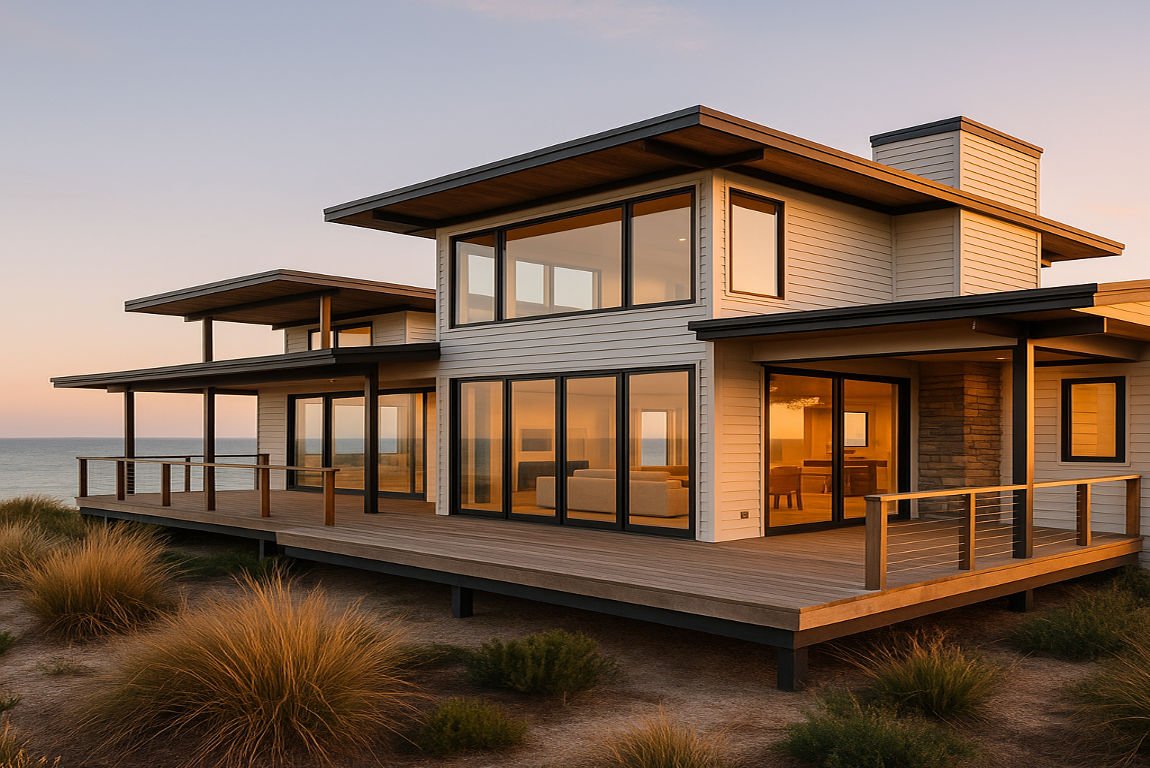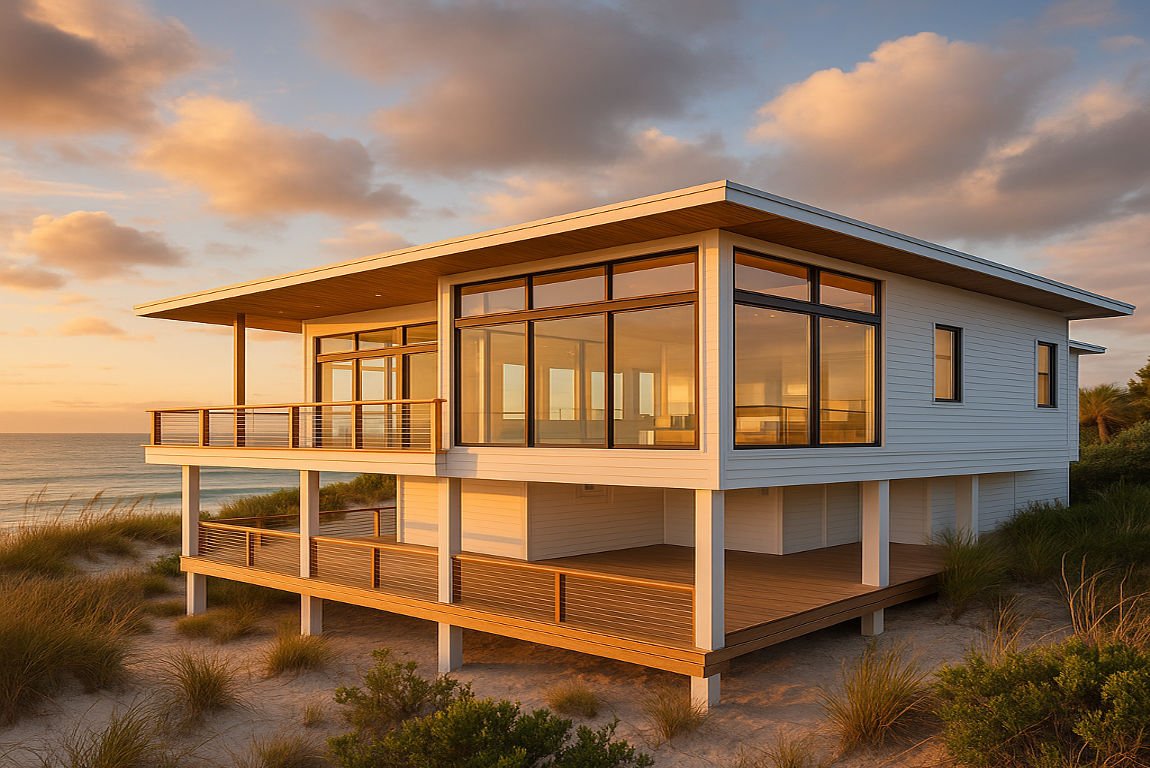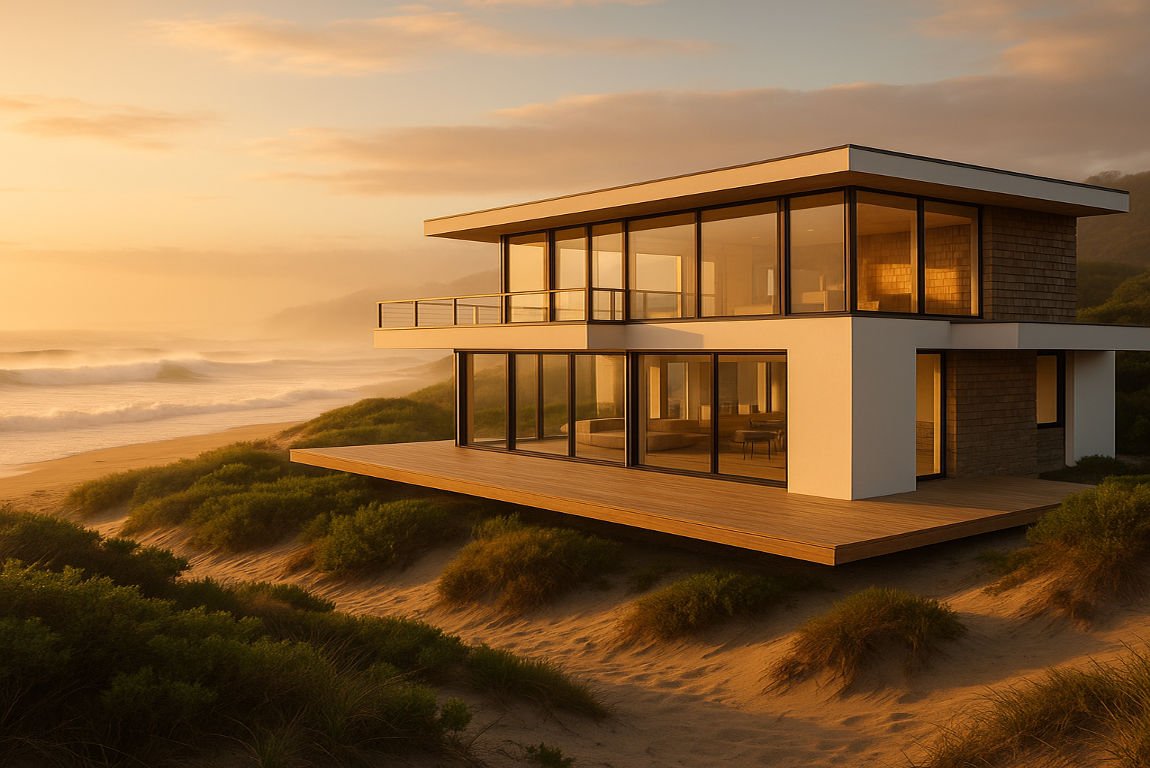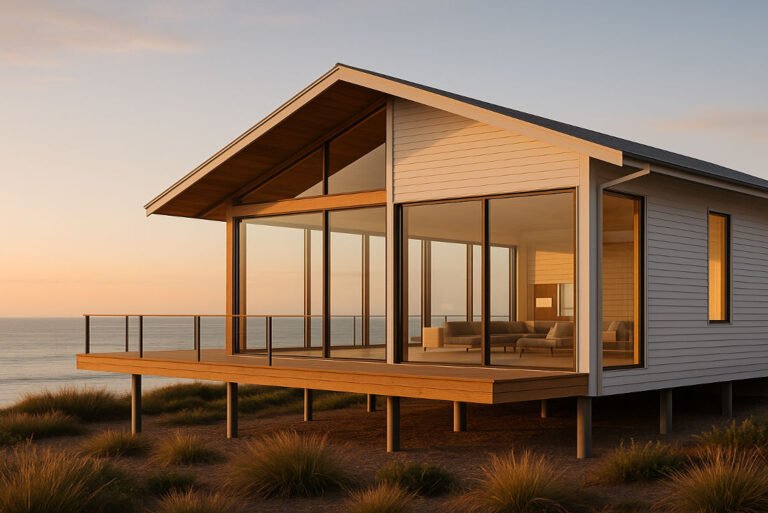Imagine waking up to the sound of crashing waves, salty breezes brushing through your windows, and the serene view of the ocean stretching endlessly. This is the charm of coastal house architecture—a style that combines functionality, resilience, and beauty to create homes perfectly suited for life by the shore.
But what is coastal house architecture, and why is it so appealing? At its core, it’s a design philosophy that harmonizes with its surroundings while addressing the unique challenges of coastal living. Whether you’re building a vacation retreat or a year-round home, coastal architecture offers a lifestyle that’s as relaxing as it is practical.
Understanding Coastal House Architecture

What Is Coastal House Architecture?
Coastal house architecture refers to a style of home design specifically tailored for coastal environments. These homes emphasize features like natural light, ventilation, and open spaces to maximize the scenic beauty and functionality of oceanfront living. At the same time, they incorporate structural elements to withstand the unique challenges posed by the sea, such as salt air, humidity, and storms.
A Brief History
Coastal house architecture has evolved over centuries, drawing inspiration from seaside cottages, fishing villages, and traditional beach homes. Early coastal designs were heavily influenced by local materials and climate conditions, with simple, utilitarian forms. Over time, these homes integrated modern innovations, blending style with practicality. Today, coastal homes range from rustic shacks to sleek, contemporary designs that prioritize sustainability and resilience.
The Core Philosophy
At its heart, coastal architecture is about harmonizing with the environment. These homes are designed to coexist with nature, maximizing views, embracing natural light, and minimizing environmental impact. Resilience is also key—elevated foundations, durable materials, and aerodynamic shapes ensure these homes can withstand the forces of nature while maintaining their aesthetic appeal.
Key Characteristics of Coastal House Architecture

So, what makes a coastal home truly unique? Let’s dive into the defining features of this architectural style.
Use of Natural Materials
Coastal homes are often built using materials such as wood, stone, and glass, which blend seamlessly with the surrounding natural environment. These materials not only enhance the aesthetic appeal but are also chosen for their durability in harsh coastal conditions.
You may also read (explore the world of famous house styles).
Large Windows and Glass Doors
To make the most of ocean views, coastal homes feature floor-to-ceiling windows, sliding glass doors, and skylights. These additions flood the interiors with natural light, creating a bright and airy atmosphere.
Open Floor Plans
Coastal homes embrace open-concept living, where spaces flow seamlessly from one to another. This design fosters a sense of connectedness, allowing the beauty of the outdoors to feel like an extension of the interior.
Elevated Foundations
To protect against flooding, many coastal homes are built on stilts, piers, or elevated platforms. This not only safeguards the house but also creates opportunities for storage or outdoor living spaces beneath the structure.
Soft, Neutral Color Palettes
Inspired by the sea, sand, and sky, coastal homes often feature soft whites, blues, and neutral tones. These colors evoke a calming, beach-like atmosphere and reflect the natural surroundings.
Emphasis on Ventilation
Good airflow is essential in coastal environments. Coastal homes often have large, operable windows, cross-ventilation systems, and open layouts that allow breezes to flow freely through the space.
Popular Coastal Architecture Styles

Coastal house architecture isn’t one-size-fits-all. Let’s explore some of the most popular styles and their unique traits.
Traditional Beach House Style
This style is casual and informal, often built on stilts to protect against flooding. Traditional beach houses feature wraparound porches, shingle siding, and a cozy, lived-in feel.
Modern Coastal Style
Modern coastal homes adopt a minimalist approach, characterized by clean lines, sleek finishes, and contemporary materials such as concrete and steel. These homes focus on simplicity while incorporating coastal elements, such as large windows and natural materials.
Coastal Modern Architecture
A fusion of modern design and traditional coastal elements, coastal modern architecture emphasizes sustainability and functionality. These homes often feature solar panels, rainwater harvesting systems, and energy-efficient appliances, blending style with eco-conscious living.
Regional Variations
Coastal architecture also adapts to the specific geography and climate of different regions. For example, New England coastal homes often feature weathered shingles, while Mediterranean coastal homes incorporate terracotta roofs and stucco exteriors.
Designing a Coastal House: Essential Elements

Designing a coastal home requires thoughtful planning to strike a balance between aesthetics, functionality, and resilience. Here’s what you need to consider:
Site Selection and Orientation
Choosing the right site is critical. Coastal homes should be oriented to maximize ocean views, sunlight, and natural breezes while minimizing exposure to harsh weather conditions.
Window Placement
Windows are a key feature of coastal homes. Incorporate sliding glass doors, picture windows, and skylights to create a seamless connection between the indoors and outdoors.
You may also read (a guide to understanding mediterranean house design).
Material Choices
Durability is crucial. Opt for materials like fiber cement siding, weather-resistant wood, and corrosion-resistant metals that can withstand the challenges of coastal environments.
Outdoor Living Spaces
Coastal homes often extend their living areas outdoors with decks, patios, and outdoor kitchens. These spaces are perfect for enjoying the ocean breeze and hosting gatherings.
Landscaping
Design the landscape with native, salt-tolerant plants that thrive in coastal conditions. This not only enhances the aesthetic but also minimizes maintenance.
Storm-Resistant Features
Incorporate features like hurricane shutters, impact-resistant windows, and reinforced roofs to protect against extreme weather events.
Sustainability in Coastal House Architecture
Sustainability is becoming a cornerstone of coastal design. Here’s how eco-friendly practices are integrated:
- Eco-Friendly Materials: Use locally sourced, renewable materials like bamboo, reclaimed wood, and recycled glass.
- Energy Efficiency: Install solar panels, smart thermostats, and energy-efficient appliances to reduce the home’s carbon footprint.
- Water Management: Incorporate rainwater harvesting systems and permeable paving to handle water runoff effectively.
- Natural Ventilation: Design homes to rely on breezes for cooling instead of air conditioning, reducing energy consumption.
Benefits of Coastal House Architecture
Why are so many people drawn to coastal homes? Here are some reasons:
- Connection with Nature: Coastal homes offer unparalleled access to the outdoors, promoting mental and physical well-being.
- Natural Light and Ventilation: These homes are designed to maximize natural light and airflow, creating a bright and healthy living environment.
- Resilience: Coastal homes are built to withstand harsh weather, offering safety and peace of mind.
- Aesthetic Appeal: The clean lines, natural materials, and ocean-inspired colors make these homes visually stunning.
- Property Value: Coastal properties often see higher demand, making them a great investment.
Challenges and Considerations
Of course, building a coastal home comes with its challenges:
ChallengeSolution
Building Regulations Work with local architects familiar with coastal zoning laws.
Maintenance: Use corrosion-resistant materials and schedule regular upkeep.
High Costs Budget for durable materials and elevated foundations.
Environmental Impact: Use sustainable practices and materials to minimize your ecological footprint.
Future Trends in Coastal House Architecture
The future of coastal design is all about innovation and sustainability:
- Smart Home Technology: Expect to see more integrated systems for energy management and security.
- Climate Resilience: Architects are focusing on materials and designs that can better withstand rising sea levels and increasing storm intensity.
- Minimalist Design: Simple, timeless designs that prioritize functionality and harmony with nature are gaining popularity.
Case Studies and Inspirational Examples
Let’s look at some examples of coastal homes that capture the essence of this architectural style:
- The Hamptons Retreat: A classic New England-style home featuring weathered shingles, wraparound decks, and panoramic ocean views.
- Modern Malibu Villa: A sleek, glass-walled home with sustainable features like solar panels and drought-resistant landscaping.
You may also read (mastering home kitchen outlet placement what you need to know).
